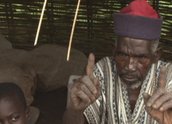


End of the Rainbow (2007)
Synopsis
End of the Rainbow is an Australian-French co-production that tracks an industrial gold mine being dismantled piece by piece in Kalimantan, Borneo in Indonesia and reconstructed in a remote part of Guinea, West Africa. To make way for the mine, some villages had to be relocated whether the inhabitants liked it or not. The film portrays the irreversible changes brought by the mine and the universal human desire for a better life. End of the Rainbow allows the audience to contemplate the circumstances for the local populations as well as for the mine managers, military and foreign workers.
Curator’s notes
End of the Rainbow does not name any of the people appearing in the film or the gold mining multinational, which is unusual. The film is a closely observed study of the impact of global mining on local populations, their traditions, economies and environments. It could have taken place somewhere else and the issues would be much the same. End of the Rainbow is a beautifully crafted documentary – gentle, poetic and contemplative in its execution, even though it portrays a world of dramatic change.
Director Robert Nugent uses two ‘griots’ as part of the storytelling. They are local praise singers who keep the oral tradition alive in their villages and appear in the film as musician-narrators. Nugent found them when he was visiting their villages around the mine. Griots provide the news, synthesise family histories and comment on events that would be difficult for individuals to speak out on. They are marriage counsellors, circumcision celebrants, convenors of festivities and regulators of myths.
One of the griots appears early on in the film at night playing a very unusual looking instrument called a ‘bolon’ on the edge of a fire. He performs several times throughout the film asking pertinent questions such as ‘What is the value of gold?’ and proclaiming information to ponder upon, such as the attitudes of many of the villagers toward the mine. Also helping to tell the story are two local chiefs who are the spokespeople for their villages. The Banko village chief, a farmer, puts things in perspective (see clip one).
The juxtaposition of images in the film is frequently striking: the overwhelming size, shapes and textures of the machinery set against the backdrop of the village and landscape (see clip two). Balancing the images of degradation of the landscape, the dire effects of cyanide, the illegal mining and village life are interesting glimpses of mine movers, and mine administrators and managers at leisure and work.
Illegal panning is rampant and the mine workers call out the military to scout, chase and arrest the illegal gold seekers. One of the managers explains that it’s safety that the mine owners are worried about (see clip three). At first this seems spurious and just an excuse to stop the people taking away company profits, but in another part of the film, a villager speaks about his wife being killed in the mine at night when it was raining.
The documentary raises many important questions for us to consider – how the multinational corporation came to buy this land, what kind of government corruption exists, why the villagers don’t receive more of the profits to enable them to survive or get some of the land back to continue their tradition of looking for gold. As the Toronto International Film Festival review stated, End of the Rainbow is 'an impeccably executed documentary that illustrates the invisible, anonymous power of the global market that affects all of society’.
End of the Rainbow screened on SBS Television on 17 October 2008 and at over 20 international film festivals. Prizes won at festivals include Best Documentary awards in Lisbon, Brazil, Belfast and Paris; the First Appearance Award at the International Documentary Festival in Amsterdam; and Best International Feature at the Taiwan International Documentary Festival.
- Overview
- Curator’s notes
- Video 3 clips
- Principal credits
- Find a copy
- Make a comment
- Map
- Add your review



